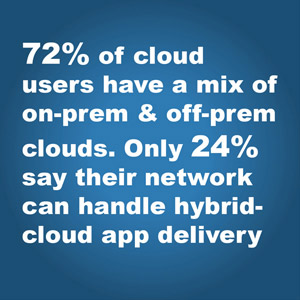We’ve all heard the myriad ways cloud computing has improved mobility and increased accessibility to new business software. Businesses are now able to work from anywhere and from any device, but performance of applications delivered over the cloud is only as good as the performance of a business’s internal network. This is where network optimization tools come in.
“Whether your strategy is hybrid, multi-cloud or all cloud, success always depends on one thing—the ability of your network to keep pace”

“Today’s organizations are increasingly motivated to reassess their current network infrastructure,” said Citrix in a 2020 ebook. “Whether your strategy is hybrid, multi-cloud or all cloud, success always depends on one thing—the ability of your network to keep pace with your digital transformation.”
About 72% of cloud users have a mix of on-premises and off-premises clouds, according to Citrix. But only 24% say their network performance can meet the needs of their hybrid-cloud app delivery.
Related reading: Hybrid Cloud Hosting: Hybrid Cloud Just Got Easier
In this post we will discuss how optimizing network performance is key to getting the highest ROI possible out of your cloud applications. But first let’s start with a simple definition.
What is Network Optimization?
Networking optimization is an information technology process aimed at improving the performance of a business’s networking technology and remote connectivity. There are a variety of network optimization tools and best practices used to identify bottlenecks, monitor and boost performance. These techniques may include global load balancing, minimizing latency, tracking packet loss, network security monitoring and bandwidth management.
Why is Network Optimization Important

As internal IT shops adopt multi-cloud and hybrid approaches to deliver applications to their business, the need for networking optimization becomes critical. In fact, 40% of IT leaders say their network only satisfies some of their needs, according to Citrix. Networking optimization is critical for improved performance and security of a cloud environment.
Network Optimization Benefits
The benefits of optimizing network performance include:
- Reduced IT costs with increased efficiency
- Generate revenue by improving team performance
- Generate revenue by improving performance of your customer facing technology
- Reduce application downtime
- Ensure smooth delivery to remote employees on various devices
- Improve visibility into application performance with real-time reporting
- Enhance IT’s ability to predict how infrastructure and software changes will impact networks
A cloud enablement strategy can help optimize performance of your apps. Cloud Enablement: What It Is And How To Get Started
How to Measure Network Performance
With the complexity of modern IT infrastructure environments, measuring network performance is its own challenge and often requires a holistic approach. This means taking a measure of your entire network from internal devices, routers and WANs or SD-WANs, to processes, applications, websites, and more. A business will likely monitor a combination of the metrics below to measure and optimize performance:
5 Key Metrics for Improving Network Performance
- Network Availability: This refers to the percentage of a given time frame in which all of a business’s network resources were available. Generally, the standard goal is 99.9999999% uptime.
- Network Traffic: By measuring inbound and outbound patterns of bandwidth traffic administrators can quickly determine how much of their available bandwidth is being used, which workloads are using the most bandwidth and more. This allows them to make informed changes to increase performance.
- Network Latency: Latency is an accurate way to measure network speed. It refers to the amount of delay that occurs as data is sent over the network. For example, the amount of time between when one person clicks send on an email and when it lands in the recipient’s inbox.
- Network Jitter: Network jitter is simply inconsistency in a data stream causing some data packets to be delivered more slowly than others. This results in poor user experience especially when video conferencing and similar streaming user scenarios.
- Network Service Delivery: This refers to all the processes and tasks performed by IT teams in order to enable users and devices to access a business’s computer network. This commonly includes provisioning network connections and resources, providing project support, configuring platforms, ensuring quality of service, managing network security and handling network troubleshooting. Measuring IT service levels to the organization is critical to improving and optimizing user experience.
What Affects Network Performance
There are a few common causes behind poor network performance. When monitoring for network performance optimization, IT administrators will keep an eye out for the following:
- Aging or malfunctioning hardware including routers, cables, modems etc.
- Inadequate hardware, server space etc.
- Weak network security
- Users and devices draining bandwidth
- Malware
- Clunky applications that suck up too much bandwidth
- High usage of video streaming and other high-bandwidth activities
- Imperfect design or architecture
Network Optimization Tools
There are solution and service providers to help implement networking optimization initiatives. Some of the common tools and techniques used include:
- Traffic shaping
- Load balancing
- Tracking packet loss
- Data Compression
- Bandwidth management
- Elimination of redundant data
- Data caching
- Data protocol streamlining
- Buffer tuning
What’s Driving the Network Optimization Trend?

As we said in the intro to this post, rapid adoption of cloud computing and growth of remote work have led to increasingly complex IT ecosystems and greater strain on business networks. In fact, 82% of IT leaders feel hindered by network complexity, according to Citrix. Along with increased complexity, the amount of data being generated has increased exponentially and bandwidth usage is growing at an increasing rate. To meet these new demands, network optimization has become a top priority.
Top 5 Demands On IT Shops Around Cloud App Delivery
According to Citrix these are the top demands organizations are putting on their IT departments for cloud app performance.
- Increased Security 80%
- Improved Reliability 58%
- Enhanced Visibility 44%
- Simplified Management 42%
- Consistent Policy and Control 41%
Related Reading: The Difference Between Cloud Computing and Cloud Storage
Final Takeaway
The race to improve operational performance and keep a competitive advantage is increasingly reliant on cloud applications and data. Data storage and bandwidth are ongoing challenges that IT shops have to meet. Network optimization is therefore an ongoing process to maximize the efficiency of a business’s network. As we said at the start of this post, performance of cloud technology is only as good as the performance of a business’s internal network.
An application hosting provider can help free up space and bandwidth on your internal network. Find out how:

